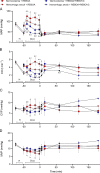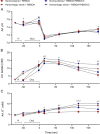A randomized porcine study of the hemodynamic and metabolic effects of combined endovascular occlusion of the vena cava and the aorta in normovolemia and in hemorrhagic shock
- PMID: 33496552
- PMCID: PMC8081444
- DOI: 10.1097/TA.0000000000003098
A randomized porcine study of the hemodynamic and metabolic effects of combined endovascular occlusion of the vena cava and the aorta in normovolemia and in hemorrhagic shock
Abstract
Background: Mortality from traumatic retrohepatic venous injuries is high and methods for temporary circulatory stabilization are needed. We investigated survival and hemodynamic and metabolic effects of resuscitative endovascular balloon occlusion of the aorta (REBOA) and vena cava inferior (REBOVC) in anesthetized pigs.
Methods: Twenty-five anesthetized pigs in normovolemia or severe hemorrhagic shock (controlled arterial bleeding in blood bags targeting systolic arterial pressure of 50 mm Hg, corresponding to 40-50% of the blood volume) were randomized to REBOA zone 1 or REBOA+REBOVC zone 1 (n = 6-7/group) for 45 minutes occlusion, followed by 3-hour resuscitation and reperfusion. Hemodynamic and metabolic variables and markers of end-organ damage were measured regularly.
Results: During occlusion, both the REBOA groups had higher systemic mean arterial pressure (MAP) and cardiac output (p < 0.05) compared with the two REBOA+REBOVC groups. After 60 minutes reperfusion, there were no statistically significant differences between the two REBOA groups and the two REBOA+REBOVC groups in MAP and cardiac output. The two REBOA+REBOVC groups had higher arterial lactate and potassium concentrations during reperfusion, compared with the two REBOA groups (p < 0.05). There was no major difference in end-organ damage markers between REBOA and REBOA+REBOVC. Survival after 1-hour reperfusion was 86% and 100%, respectively, in the normovolemic REBOA and REBOA+REBOVC groups, and 67% and 83%, respectively, in the corresponding hemorrhagic shock REBOA and REBOA+REBOVC groups.
Conclusion: Acceptable hemodynamic stability during occlusion and short-term survival can be achieved by REBOA+REBOVC with adequate resuscitation; however, the more severe hemodynamic and metabolic impacts of REBOA+REBOVC compared with REBOA must be considered.
Level of evidence: Prospective, randomized, experimental animal study. Basic science study, therapeutic.
Copyright © 2021 The Author(s). Published by Wolters Kluwer Health, Inc. on behalf of the American Association for the Surgery of Trauma.
Figures



Similar articles
-
The effect of an endovascular Heaney maneuver to achieve total hepatic isolation on survival, hemodynamic stability, retrohepatic bleeding, and collateral flow in a porcine model.Eur J Trauma Emerg Surg. 2024 Aug;50(4):1547-1557. doi: 10.1007/s00068-024-02482-2. Epub 2024 Mar 8. Eur J Trauma Emerg Surg. 2024. PMID: 38456908 Free PMC article.
-
Resuscitative endovascular balloon occlusion of the inferior vena cava is made hemodynamically possible by concomitant endovascular balloon occlusion of the aorta-A porcine study.J Trauma Acute Care Surg. 2020 Jan;88(1):160-168. doi: 10.1097/TA.0000000000002467. J Trauma Acute Care Surg. 2020. PMID: 31397743
-
Total resuscitative endovascular balloon occlusion of the aorta causes inflammatory activation and organ damage within 30 minutes of occlusion in normovolemic pigs.BMC Surg. 2020 Mar 2;20(1):43. doi: 10.1186/s12893-020-00700-3. BMC Surg. 2020. PMID: 32122358 Free PMC article.
-
Resuscitative Endovascular Balloon Occlusion of the Aorta (REBOA) Use in Animal Trauma Models.J Surg Res. 2021 Dec;268:125-135. doi: 10.1016/j.jss.2021.06.052. Epub 2021 Jul 23. J Surg Res. 2021. PMID: 34304008 Review.
-
Resuscitative endovascular balloon occlusion of the aorta.Resuscitation. 2015 Nov;96:275-9. doi: 10.1016/j.resuscitation.2015.09.003. Epub 2015 Sep 16. Resuscitation. 2015. PMID: 26386370 Review.
Cited by
-
A porcine study of ultrasound-guided versus fluoroscopy-guided placement of endovascular balloons in the inferior vena cava (REBOVC) and the aorta (REBOA).Trauma Surg Acute Care Open. 2023 May 12;8(1):e001075. doi: 10.1136/tsaco-2022-001075. eCollection 2023. Trauma Surg Acute Care Open. 2023. PMID: 37205275 Free PMC article.
-
A clinical study of the hemodynamic and metabolic effects of Zone 3 REBOA for sacral and pelvic tumor resections.BMC Surg. 2022 Jun 27;22(1):246. doi: 10.1186/s12893-022-01694-w. BMC Surg. 2022. PMID: 35761238 Free PMC article.
-
Our initial experience of monitoring the autoregulation of cerebral blood flow during cardiopulmonary bypass.J Extra Corpor Technol. 2023 Dec;55(4):209-217. doi: 10.1051/ject/2023032. Epub 2023 Dec 15. J Extra Corpor Technol. 2023. PMID: 38099638 Free PMC article.
-
A randomized porcine study of hemorrhagic shock comparing end-tidal carbon dioxide targeted and proximal systolic blood pressure targeted partial resuscitative endovascular balloon occlusion of the aorta in the mitigation of metabolic injury.Intensive Care Med Exp. 2023 Apr 10;11(1):18. doi: 10.1186/s40635-023-00502-w. Intensive Care Med Exp. 2023. PMID: 37032421 Free PMC article.
-
The effect of an endovascular Heaney maneuver to achieve total hepatic isolation on survival, hemodynamic stability, retrohepatic bleeding, and collateral flow in a porcine model.Eur J Trauma Emerg Surg. 2024 Aug;50(4):1547-1557. doi: 10.1007/s00068-024-02482-2. Epub 2024 Mar 8. Eur J Trauma Emerg Surg. 2024. PMID: 38456908 Free PMC article.
References
-
- Ciresi KF, Lim RC, Jr. Hepatic vein and retrohepatic vena caval injury. World J Surg. 1990;14(4):472–477. - PubMed
-
- Buechter KJ, Sereda D, Gomez G, Zeppa R. Retrohepatic vein injuries: experience with 20 cases. J Trauma. 1989;29(12):1698–1704. - PubMed
-
- Khaneja SC, Pizzi WF, Barie PS, Ahmed N. Management of penetrating juxtahepatic inferior vena cava injuries under total vascular occlusion. J Am Coll Surg. 1997;184(5):469–474. - PubMed
-
- Millikan JS, Moore EE, Cogbill TH, Kashuk JL. Inferior vena cava injuries–a continuing challenge. J Trauma. 1983;23(3):207–212. - PubMed
Publication types
MeSH terms
LinkOut - more resources
Full Text Sources
Other Literature Sources
Research Materials

